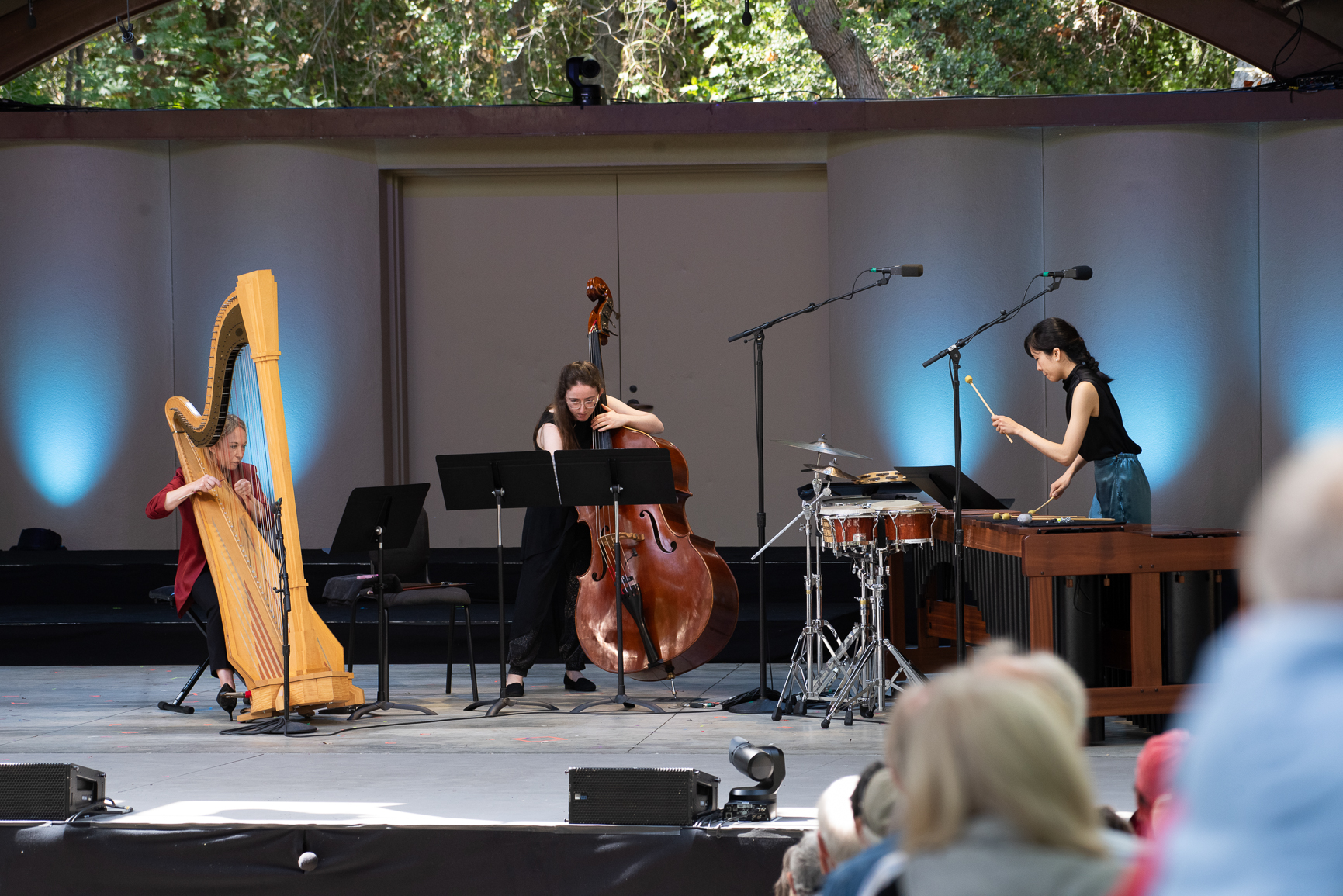
The 78th annual Ojai Music Festival opened on Thursday June 6, 2024 and continued through Sunday June 9. The Music Director for this year was Mitsuko Uchida. Featured artists included the Mahler Chamber Orchestra, soprano Lucy Fitz Gibbon, violinist Alexi Kenney , cellist Jay Campbell, bassist Rick Stotijn and the Brentano String Quartet. The Ojai Festival always brings a mixture of fresh contemporary music along with the works of cherished composers such as J.S.Bach, W.A. Mozart and Béla Bartók. The cool morning weather did not deter a good turnout for the 10:00 AM Friday concert in the Libbey Bowl.
First up was Julie Smith Phillips performing Fall, a piece for solo harp and electronics by the late Kaija Saariaho. Thomas May’s program notes state that Fall is “…an arresting example of Saariaho’s ability to convey an assemblage of freely associated images through the interchange of acoustic and electronic sounds and a poetics of timbre.” Repeating light phrases open Fall accompanied by a churning counterpoint in the lower registers. This produces a feeling of uncertainty that is accentuated by the absence of definite rhythms or a solid pulse. The lack of a leading melody confirms that Fall is all about texture and contrast, propelled by an active tempo. The electronics and amplification intensify the timbrel palette of the normally reserved harp, and all of this is well-managed by Ms. Phillips. There is a brief stretch of simple, solitary notes in the upper registers offset by aggressive passages below, adding a sense of mystery. A series of strong arpeggios in the higher notes follow, introducing a feeling of menace. Fall is both dramatic and atmospheric and brings the normally soft spoken harp into new and expressive territory.
Pression, by Helmut Lachenmann followed, a solo cello piece performed by Jay Campbell. The piece opens with a series of whispers and soft scratches as the bow is lightly drawn across the strings. This soon escalates to angry growling sounds and vivid thumps applied to the cello wood. Pression is a series of amazing extended techniques on the cello that varies from soft ghostly tones to a rough, mechanical sound. Campbell was in full control of his instrument despite the fact that it was operating completely beyond the conventional sonic envelope of the normally stately cello. Pression is an impressive demonstration of what is possible when the elegant is completely given over to the physical.
Five Etudes, by Sofia Gubaidulina, was next. This is a five movement piece scored for harp, percussion and double bass. “Largo”, the first movement opened solemnly with a double bass solo consisting of single notes. The harp enters, followed by pitched percussion with everyone in a slow tempo and soft dynamic. A satisfying yet gentle groove soon developed. The percussion was effective, keeping a steady pulse while the harp and bass lines weaved in and around each other. “Allegretto” followed with an increased tempo and prominent drumming by percussionist Sae Hashimoto projecting the beat. This movement was stylish and jazzy, yet tastefully restrained. The “Adagio”, movement 3, consisted of lines of quiet solitary notes from the harp that were answered by the double bass. A soft trill was heard from the pitched percussion, enhanced by a metal chain draped over one of the vibraphone plates. This contributed a slightly mysterious feeling. Strong arpeggios in the harp opened movement 4, “Allegro disparato”, accompanied by a sharp drum beat. This was uptempo, described in the program notes as a “desperate Allegro.” Rapidly repeating cells in the marimba were offset by a solemn melody in the bass.
The final etude, “Andante”, started with slow pizzicato notes in the bass and counterpoint in the harp. This evolved into a comfortable walking bass line below combined with hip riffs above; an engaging mixture. Five Etudes was perhaps the most conventional of the contemporary pieces in the Friday morning concert. The playing was skillfully done, especially by Naomi Shaham on the double bass who was a last minute substitution.
The final work on the concert program was String Quartet No. 5, by Béla Bartók performed by the Brentano String Quartet. This was written in the summer of 1934 and carries all of the weighty anxiety of pre-war Central Europe. All five movements were performed and the energy and gritty complexity of this music is striking, even at this distance in time since its premiere. The Brentano Quartet played this with precision and brilliance over its entire 31 minute length. String Quartet No. 5 remains gripping in its intensity and a showcase for the high level of creativity and extraordinary technique that was present in early 20th century music.
The Brentano Quartet is:
Mark Steinberg, violinist
Serena Canin, violinist
Misha Amory, viola
Nina Lee, cello
Photo Credit: Timothy Teague
